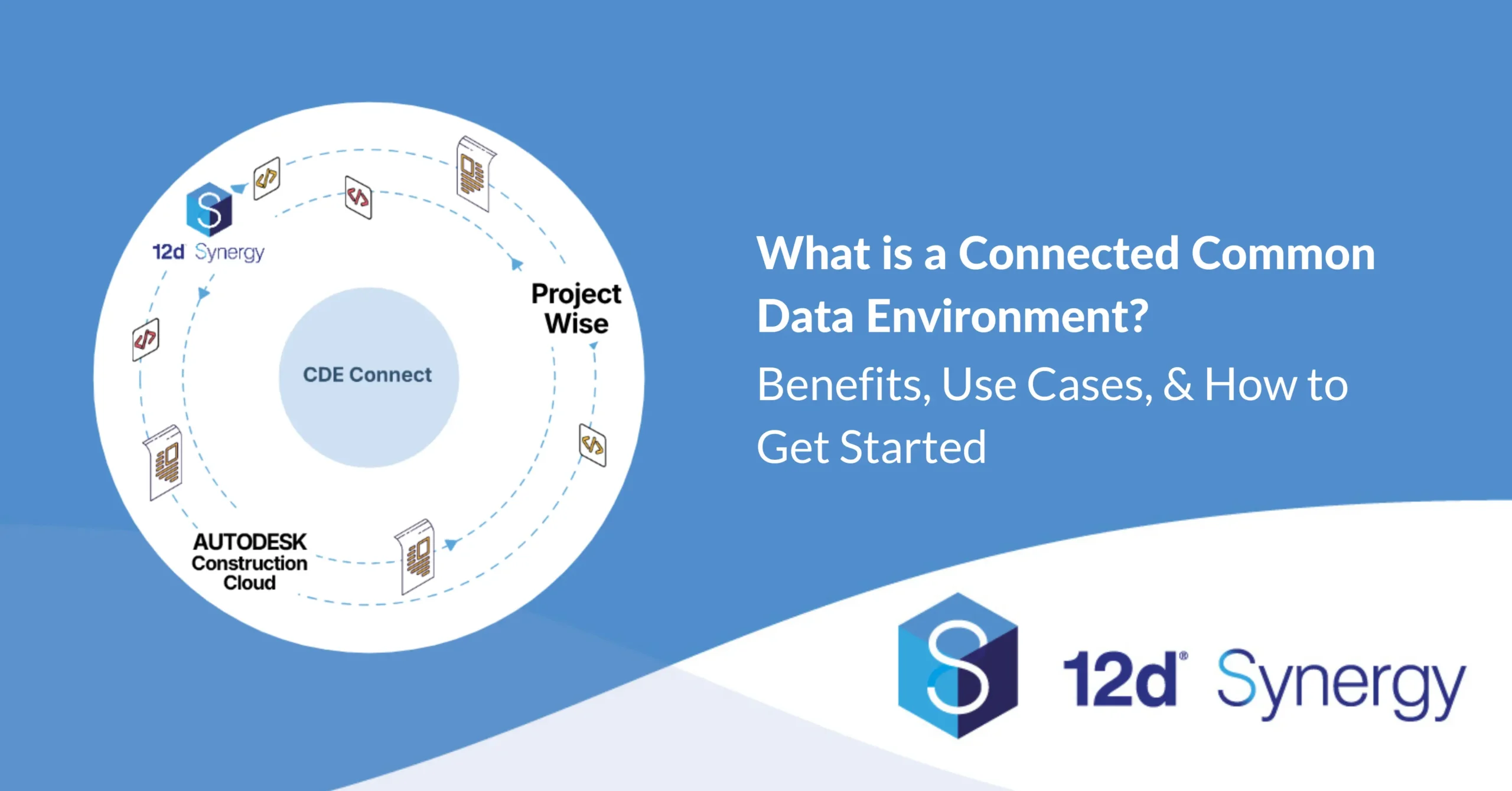The Ultimate Guide to Connected Common Data Environments
A Connected Common Data Environment (Connected CDE) is the next evolution in project information management for the AEC industry. Unlike traditional CDEs, which often operate in isolation, Connected CDEs enable seamless, secure, and standardised data exchange across multiple platforms, tools, and stakeholders regardless of vendor.
This guide explores:
- How Connected CDEs solve the challenges of data silos, rework, and inefficiency
- The key differences between single/standalone CDEs and Connected CDEs
- Difference between Open and Closed CDEs
- Real-world use cases and benefits across each project stage
- What to consider when implementing a Connected CDE in your business
By enabling interoperability, process-driven Data Flows and CDE Connect, and vendor-neutral integrations, Connected CDEs empower AEC organisations to choose the best tools for the job while maintaining a single, unified flow of accurate, structured information from design through to operations.
Whether you’re working in joint ventures, managing subcontractors, or preparing for digital handover, this guide offers the strategic and technical insights you need to future-proof your data management approach.
This guide is an accompanying post to our Ultimate Guide to Common Data Environment and the Ultimate Guide to ISO 19650. It is highly recommended reading both guides as Connected CDEs must be understood in the greater context of the Common Data Environment and ISO 19650 information management process.
Chapters
-
- Why Connected Data Matters More Than Ever in AEC Projects
- Introducing Connected Common Data Environments
- Key Features and Benefits of a Connected Common Data Environment
- The Role of Connected CDEs Across the Project Lifecycle
- Implementing a Connected Common Data Environment
- Connected Common Data Environments and ISO 19650
- Open vs. Closed CDEs
- Vision for Connected CDEs – The Future of Data Management
Get the Connected CDE eBook!
Don’t have time to read the full guide right now? Download our free in-depth eBook and share it with your team to explore how Connected CDEs can transform your data workflows—when it suits you.
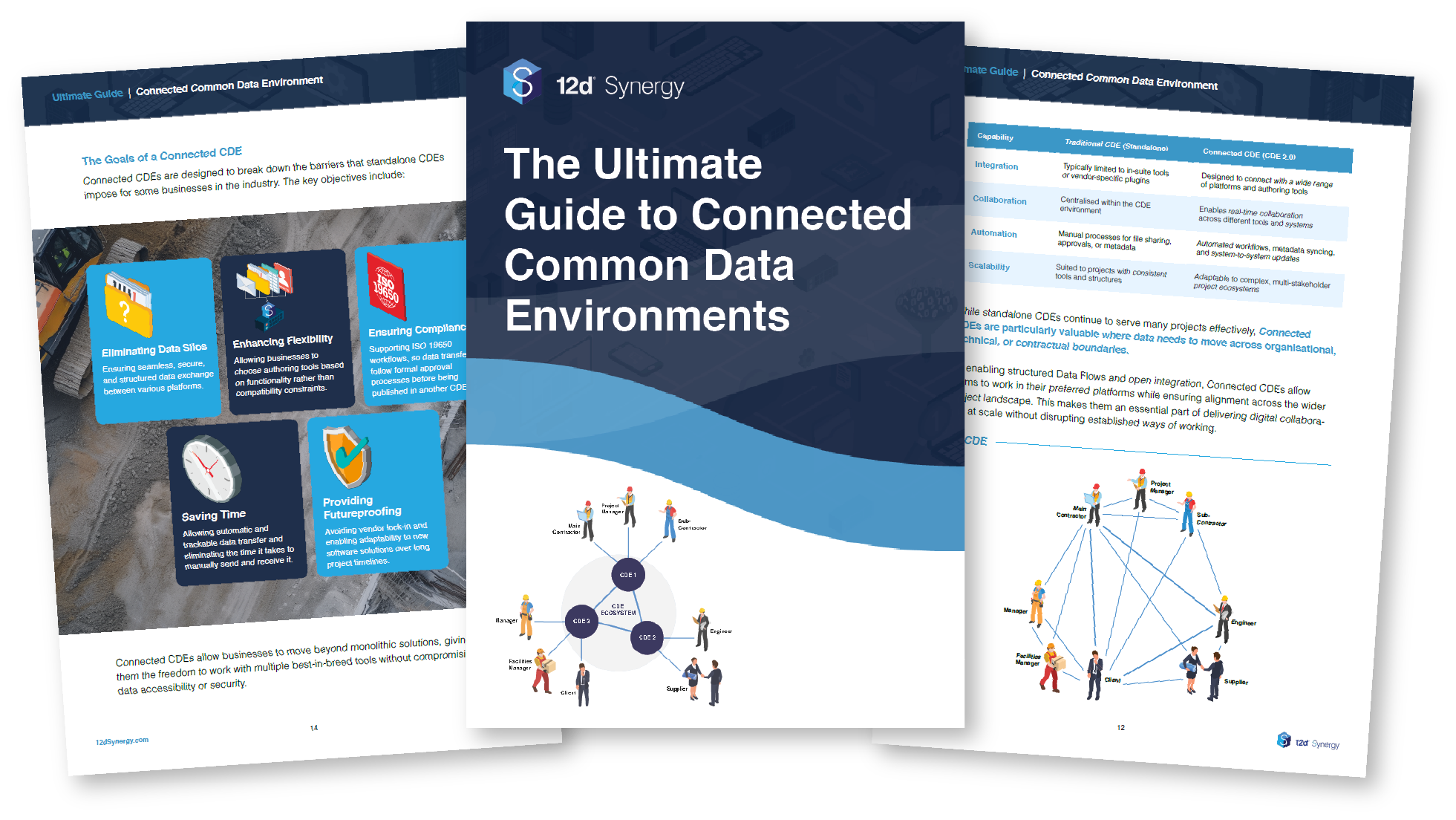
Chapter 1:
Why Connected Data Matters More Than Ever in AEC Projects
Large construction projects demand seamless coordination of people, processes, and data. To meet this challenge, the architecture, engineering, and construction (AEC) industry has long relied on Common Data Environments (CDEs) to reduce data fragmentation and improve collaboration.
Sitting at the intersection of government mandates and project delivery needs, CDEs provide a structured way to manage project information, improving consistency, compliance, and communication across teams.
The impact is clear:
- A study by Nuroject found that implementing a CDE can reduce project duration by up to 20%.
- McKinsey reports that adopting CDEs improves project efficiency by up to 20% by reducing miscommunication and data discrepancies.
- Research from the U.S. National Institute of Standards and Technology found that nearly 70% of projects using CDEs saw increases in productivity and stakeholder collaboration.
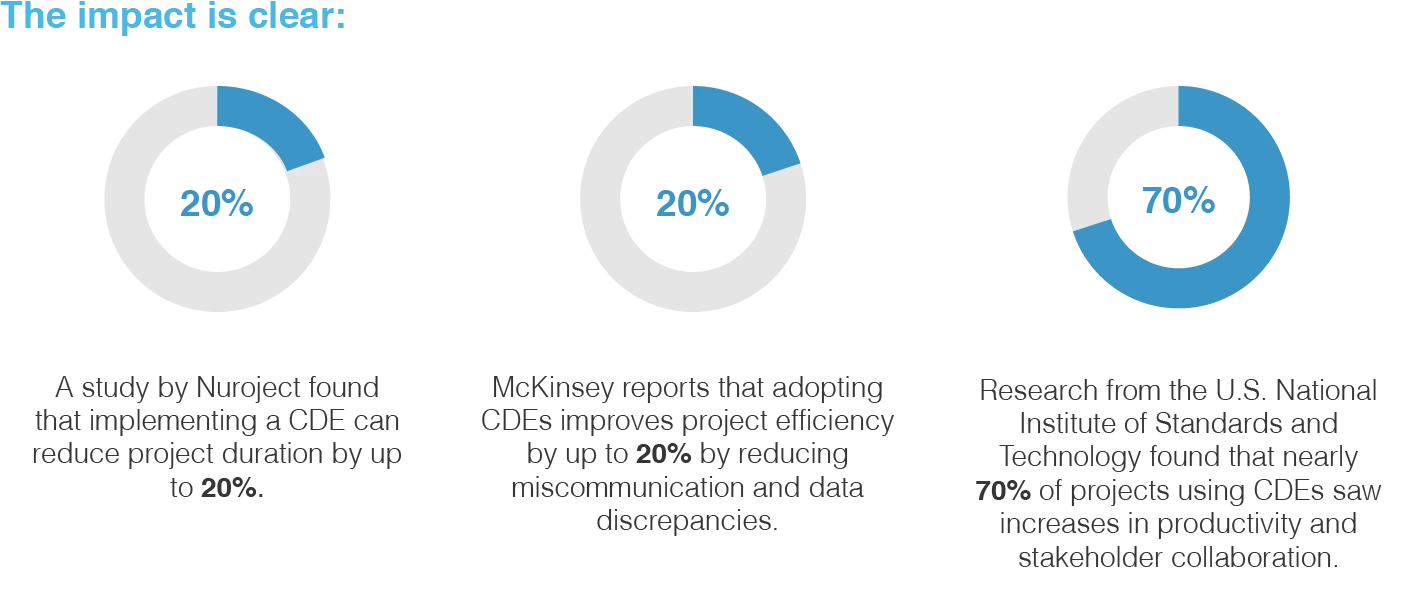
But as project complexity increases—bringing together joint ventures, multiple contractors, and diverse digital tools—many businesses are facing a new challenge: their systems don’t talk to each other.
In these environments, it’s not uncommon for different teams to use different tools or platforms, sometimes even different CDEs. However, the solution isn’t simply to adopt more systems or platforms. The real problem is disconnection, and the real opportunity lies in creating a connected environment, regardless of how many tools or systems are in play.
This is where Connected Common Data Environments (or CDE 2.0 as we like to call it) come in.
CDE 2.0 doesn’t mean having multiple CDEs. It means enabling data to flow across the platforms your teams already use—securely, intelligently, and in an automated way. It ensures that design data, cost information, field updates, and asset records all align, no matter which system they originate from.
In this guide, we’ll explore:
- The role of CDEs in managing information at scale
- Why traditional CDEs struggle to support today’s complex projects
- How Connected CDEs bring systems, standards, and stakeholders together
- What to consider when implementing a connected data strategy
Whether you’re leading a major infrastructure project or seeking to standardise your data delivery workflows, this guide will help you understand how connection—not consolidation—is the key to better collaboration and better outcomes.
Why AEC Projects Need Connected Data, Not Just More Systems
In the Architecture, Engineering, and Construction (AEC) industry, every project generates a vast and growing volume of data—from design models and specifications to RFIs, schedules, estimates, and handover documentation. This data is relied upon by a wide range of stakeholders: architects, engineers, contractors, clients, consultants, and asset owners.
Efficient, structured data management is critical to ensuring that all parties have access to accurate, timely information. When managed well, data enables better decision-making, reduces errors, minimises rework, and helps deliver projects on time and within budget. It also supports compliance with industry standards such as ISO 19650 and underpins future-ready practices like digital twins and predictive maintenance.
In today’s project environments, however, data is often spread across multiple platforms. This isn’t always by choice—it reflects the reality of complex delivery models. Large-scale infrastructure projects often involve multiple contractors, joint ventures, and specialist teams—each using different systems to manage their scope of work. It’s not uncommon for different teams to bring their own document management systems, BIM platforms, or even separate CDEs.
The challenge isn’t that there are multiple systems—it’s that these systems don’t always talk to each other.
Part of the issue is that many existing CDE platforms are designed to operate within closed ecosystems. These tools often restrict integration with external systems, locking teams into a specific vendor’s way of working. As a result, even well-established solutions may struggle to exchange data smoothly, making true collaboration across the project supply chain difficult.
What’s needed is not just more software, but a data-agnostic, connected approach that allows different systems to interoperate, share metadata, and maintain compliance in a process-driven way.
When platforms operate in isolation, information becomes fragmented. Teams may duplicate efforts, miss key updates, or struggle with version control. Manual workarounds and disconnected workflows increase risk, slow delivery, and reduce overall efficiency.
That’s why modern AEC projects require more than just centralised storage—they need connected data environments that can unify information across systems, disciplines, and delivery partners.
The Role and Limits of Single CDEs
Single Common Data Environments (CDEs) have long offered AEC projects a reliable foundation for managing information. For projects delivered by a single organisation, or with a standardised set of tools, a standalone CDE remains a valuable solution. It ensures consistency, version control, governance, and compliance in a central location.
However, today’s project landscape is rarely that simple. Most large-scale projects involve multiple stakeholders, each with their own tools and processes. Even when a single CDE is in place, it may not fully support the range of data types, workflows, or integrations required across the entire ecosystem.
This disconnect can lead to several challenges:
- Information Silos: Standalone systems often lack interoperability, making it harder to maintain a unified view of project data.
- Limited Adaptability: Some platforms may not scale or adjust easily to changing project demands or stakeholder requirements.
- Inefficient Collaboration: Without integration, teams may rely on manual updates, email chains, and disconnected tools to coordinate.
- Increased Risk of Error: Manual data entry, duplicated effort, and inconsistent updates introduce opportunities for rework and miscommunication.
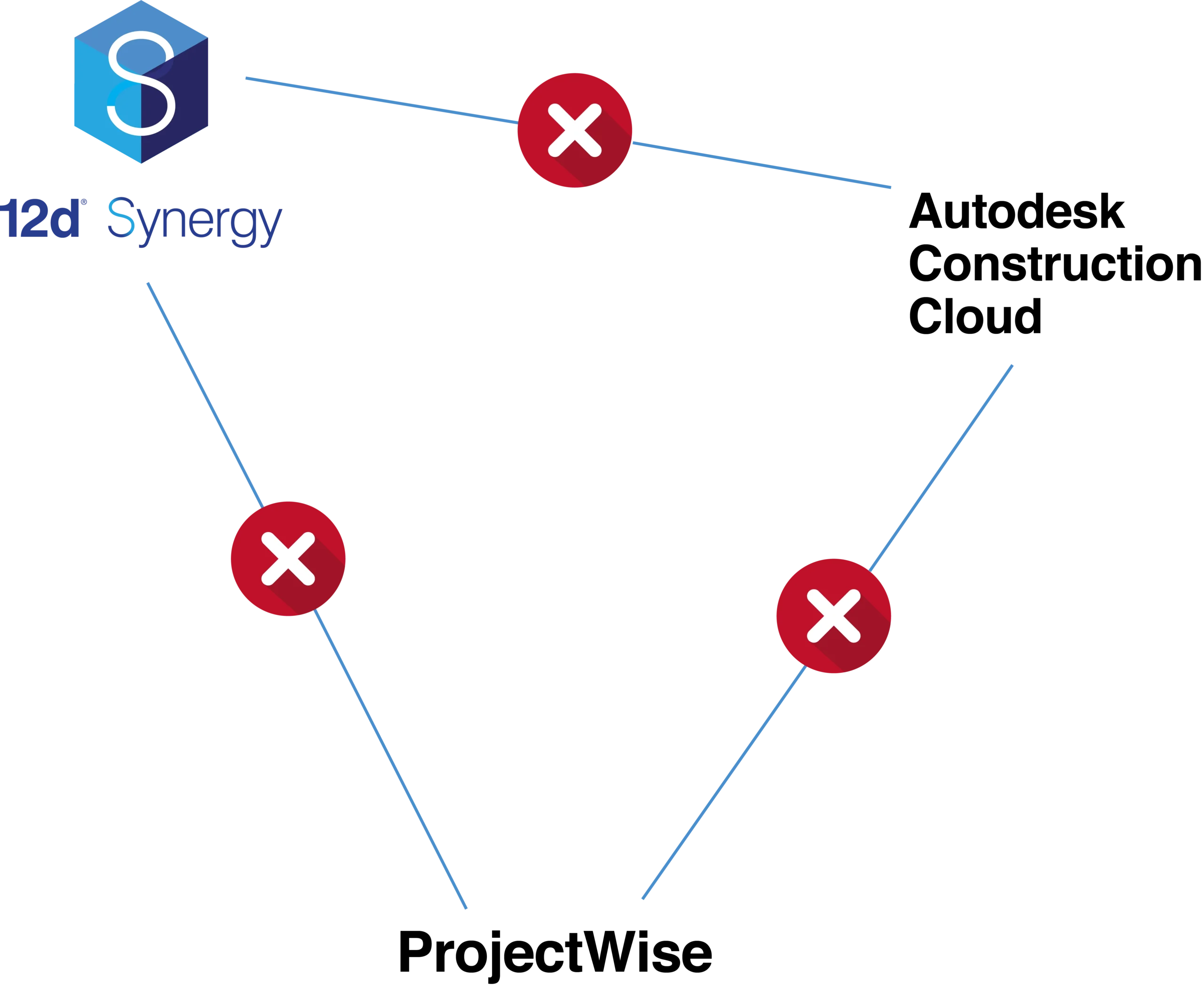
These limitations become especially visible on large infrastructure projects, where information flows across design, construction, commercial, and asset management teams—and where seamless coordination is essential.
Connected CDEs: Unifying, Not Replacing
Connected CDEs (or CDE 2.0) are designed to solve these challenges—not by replacing existing systems, but by connecting them.
A Connected CDE acts as the glue between platforms. It enables structured, automated data flows across your tech stack—whether that includes BIM software, document control platforms, ERPs, or even other CDEs. It allows each stakeholder to work in their preferred environment while ensuring that critical data remains consistent, secure, and traceable across the project lifecycle.
This connected approach delivers:
- Real-time data synchronisation
- Flexible, scalable integration across vendors and platforms
- Improved ISO 19650 alignment and metadata control
- A single, connected environment without needing to consolidate all systems into one
In short, it’s not about choosing between one CDE or many, it’s about enabling interoperability across whatever systems are already in place. Because in today’s AEC landscape, connected is better.
Chapter 2:
Introducing Connected Common Data Environments
As AEC projects grow in scale and complexity, the number of tools and platforms used across teams often increases. Project partners may rely on different software for design, survey, scheduling, documentation, and delivery—each suited to their specific role. While these systems can be highly effective individually, challenges often emerge when data needs to move between them.
Without structured integration, teams may resort to manual data transfer, version tracking via email, or disconnected workflows—leading to inefficiencies, rework, and delays.
This is where Connected Common Data Environments (Connected CDEs or CDE 2.0) come into play.
Rather than consolidating every function into a single platform, a Connected CDE links the systems already in use—enabling consistent, secure, and real-time data sharing across the project ecosystem. It supports the growing need for interoperability, automation, and flexibility, especially in large or multi-organisation project settings.
What Is a Connected CDE?
A Connected CDE is an advanced data management framework that facilitates structured communication between multiple platforms, systems, and stakeholders. It brings together various tools—such as BIM software, document management platforms, ERP systems, and even other CDEs—into a cohesive, interoperable environment.
This allows project teams to:
- Share files and metadata automatically between systems
- Maintain a consistent source of truth across different workflows
- Collaborate in real time, regardless of which platform they’re using
- Stay aligned with ISO 19650 and industry data governance standards
Instead of creating yet another standalone system, a Connected CDE acts as the bridge that ensures the systems already in place can work together effectively.
Common Data Environment: Key Concepts
At its core, Connected CDEs follow an open and data-agnostic approach, allowing businesses to use the right tools for the job without being locked into a single vendor’s ecosystem. Technologies like Data Flows and CDE Connect facilitate controlled, automated information exchange across systems.
These capabilities help:
- Eliminate manual handovers between disciplines or organisations
- Ensure accurate metadata is maintained throughout the lifecycle
- Support secure, structured collaboration across teams and tools
Connected CDEs are also built with compliance in mind, helping organisations align with ISO 19650 and other regulatory frameworks while maintaining flexibility in their tech stack.
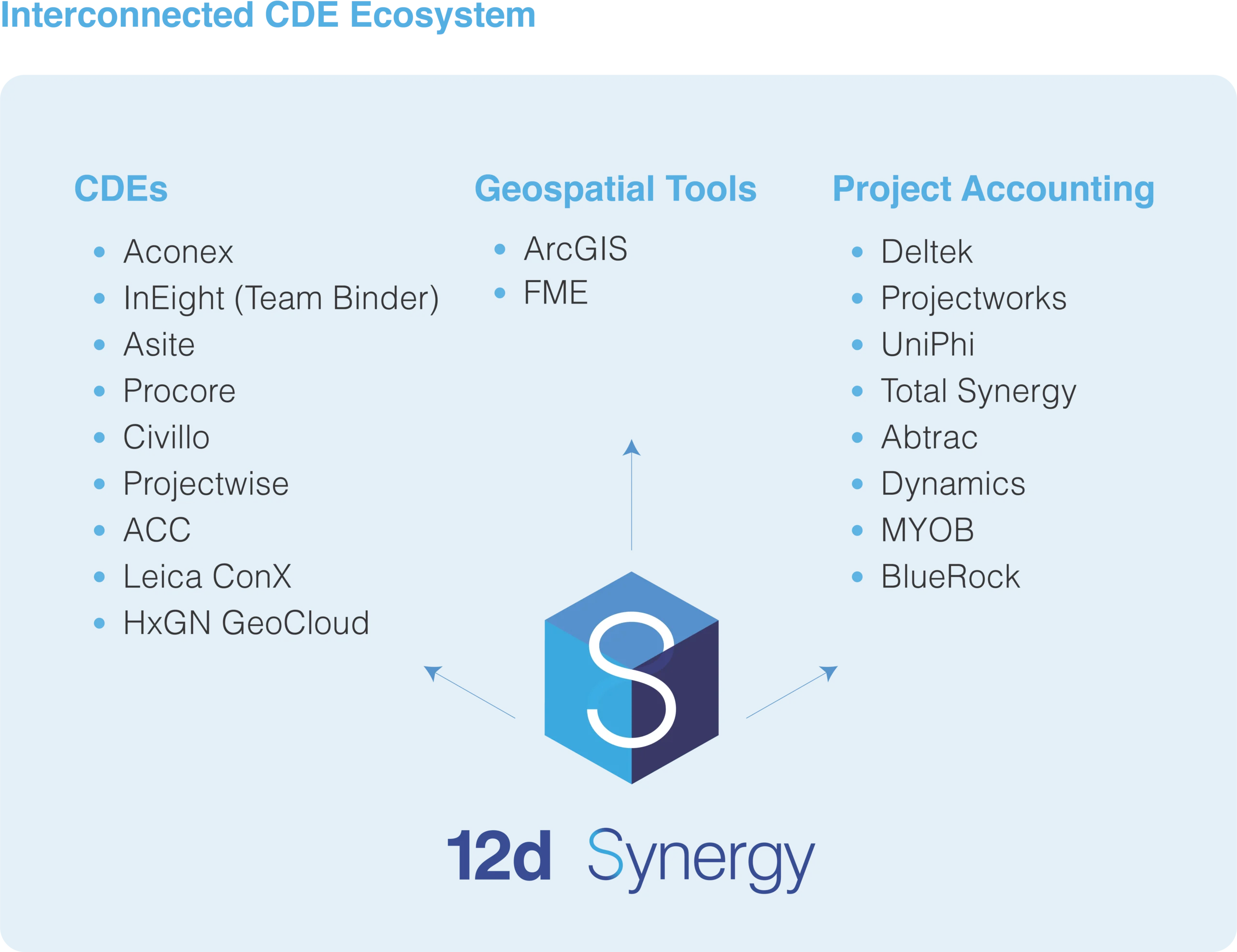
The Need for Connected CDEs Today
Modern construction and infrastructure projects are rarely delivered by a single team or through a single platform. Joint ventures, specialist consultants, subcontractors, and client-side systems are all part of the picture. Each brings their own tools, formats, and processes—creating a diverse but fragmented digital landscape.
While some teams may operate within a CDE, others may use separate environments, depending on the scope of work or contractual requirements. This diversity introduces complexity—not necessarily because there are too many systems, but because those systems are often disconnected.
Connected CDEs address this challenge by enabling structured, real-time data exchange across the project landscape. They create consistency in environments that are otherwise difficult to standardise and allow teams to stay aligned while still using their existing tools.
This model supports:
- Cross-discipline collaboration without manual reconciliation
- Faster approvals and transmittals through automated workflows
- Greater flexibility to meet client or regulatory data delivery requirements
- Scalable, long-term information management strategies
How are Connected CDEs Different from Earlier Models?
Connected CDEs (CDE 2.0) are designed to complement and extend the CDE concept for this more complex reality. They focus on enabling integration, interoperability, and automated data exchange across platforms, rather than operating as a single, standalone repository.
Here’s how the approach differs:
While standalone CDEs continue to serve many projects effectively, Connected CDEs are particularly valuable where data needs to move across organisational, technical, or contractual boundaries.
By enabling structured Data Flows and open integration, Connected CDEs allow teams to work in their preferred platforms while ensuring alignment across the wider project landscape. This makes them an essential part of delivering digital collaboration at scale—without disrupting established ways of working.
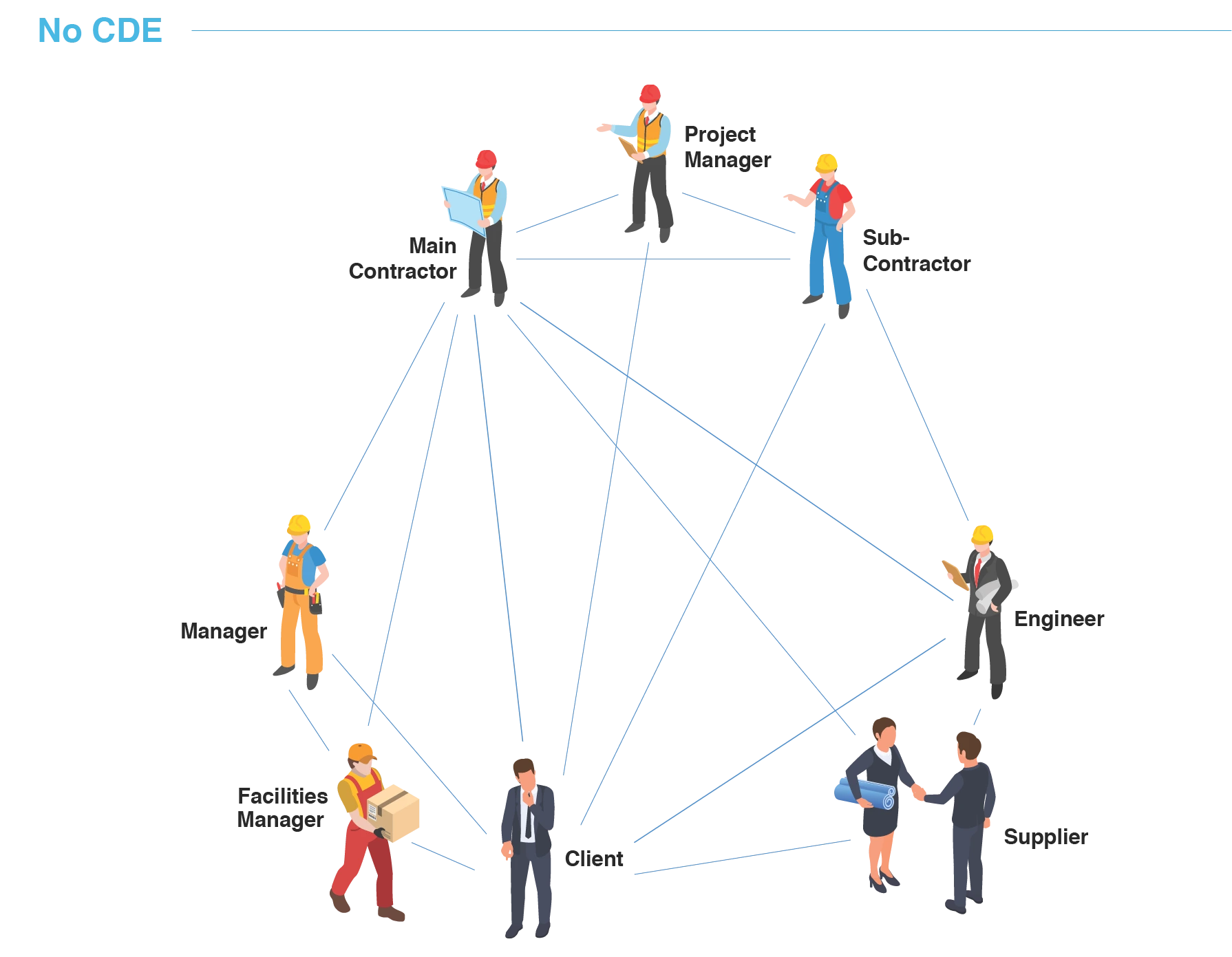
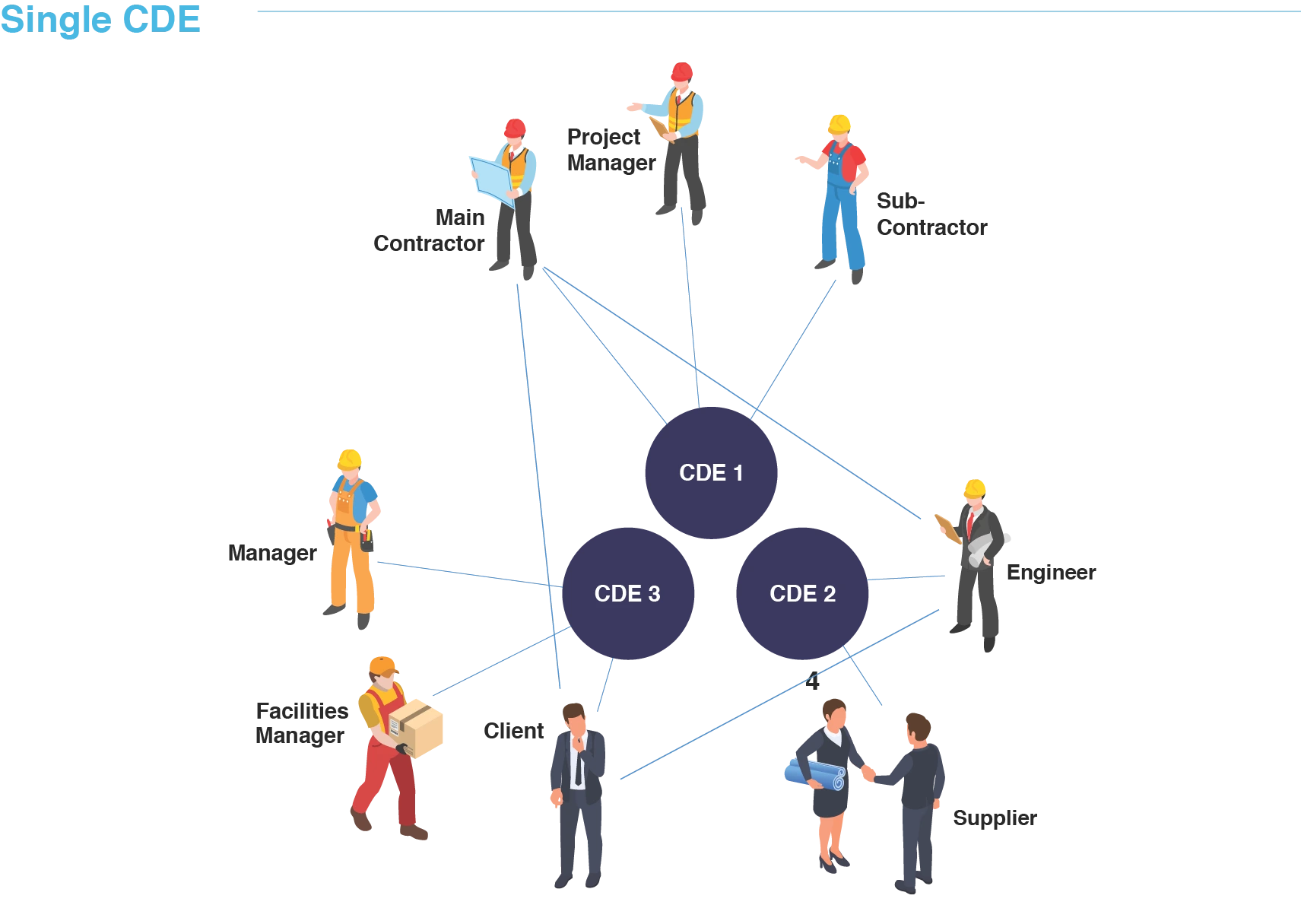
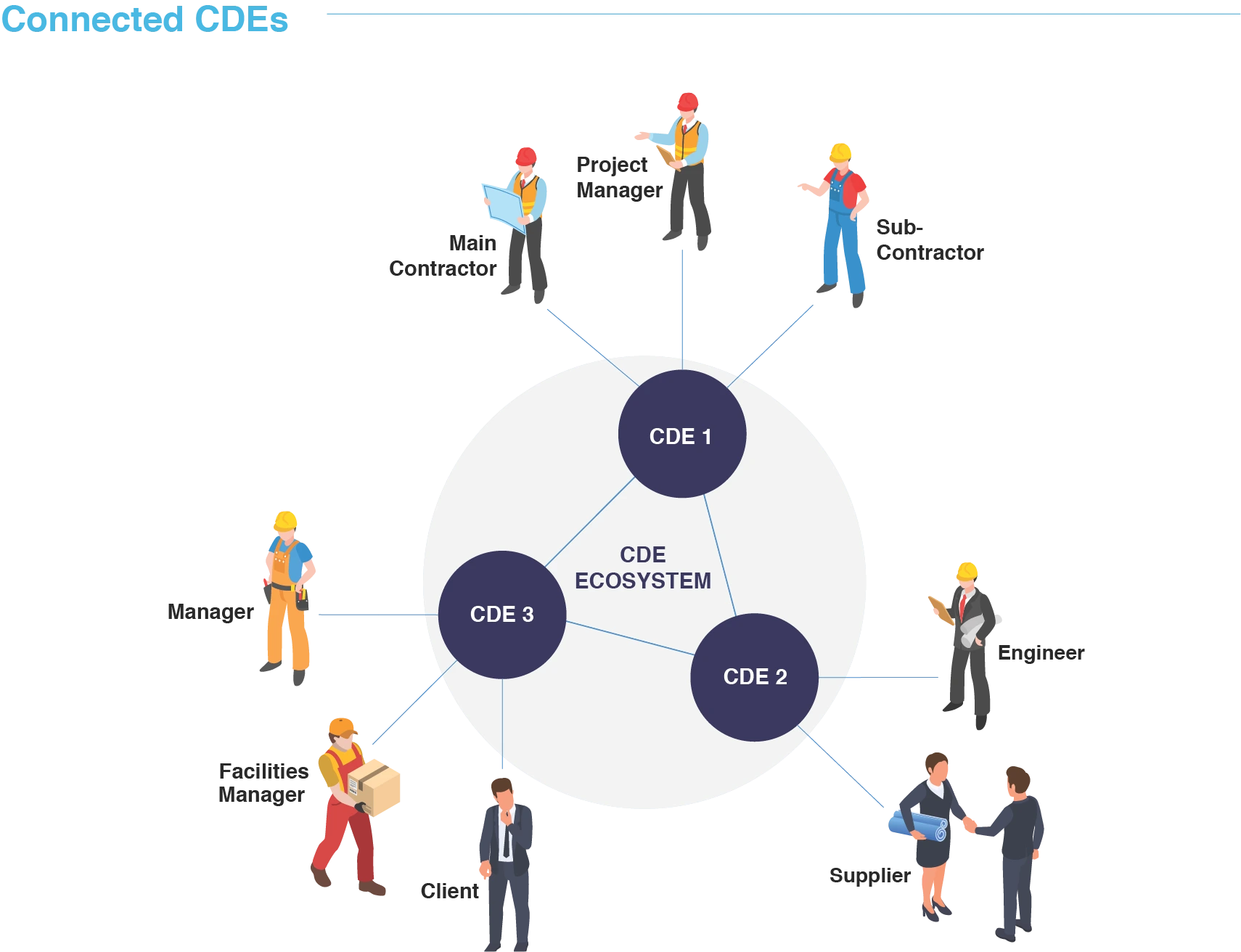
The Goals of a Connected CDE
Connected CDEs are designed to break down the barriers that standalone CDEs impose for some businesses in the industry. The key objectives include:
- Eliminating Data Silos: Ensuring seamless, secure, and structured data exchange between various platforms.
- Enhancing Flexibility: Allowing businesses to choose authoring tools based on functionality rather than compatibility constraints.
- Ensuring Compliance: Supporting ISO 19650 workflows, so data transfers follow formal approval processes before being published in another CDE.
- Saving Time: Allowing automatic and trackable data transfer and eliminating the time it takes to manually send and receive it.
- Providing Futureproofing: Avoiding vendor lock-in and enabling adaptability to new software solutions over long project timelines.
Connected CDEs allow businesses to move beyond monolithic solutions, giving them the freedom to work with multiple best-in-breed tools without compromising data accessibility or security.
Chapter 3:
Key Features and Benefits of Connected Common Data Environments
As outlined in the previous chapter, many AEC businesses today operate across multiple platforms—whether due to joint ventures, subcontractor involvement, legacy systems, or client requirements. Rather than replacing these systems, Connected CDEs provide the framework to bring them together.
This chapter takes a closer look at what makes Connected CDEs distinct. By focusing on integration, automation, and interoperability, Connected CDEs enable businesses to manage complexity without sacrificing control, compliance, or agility.
When designed well, a Connected CDE enhances—not disrupts—existing workflows. It allows teams to work within their preferred systems while ensuring that project information moves consistently, securely, and in real time across tools and teams.
Why Traditional CDE Capabilities Alone May Not Be Enough for Complex Projects
Common Data Environments have helped standardise how project information is managed and shared. Many modern CDE platforms include powerful features such as version control, role-based access, workflow automation, and audit trails. For projects delivered by a single team or within a consistent digital environment, these capabilities are often more than sufficient.
However, on large-scale or cross-organisational projects, new challenges begin to surface—not because CDEs are ineffective, but because the digital landscape around them is more complex. In these settings, project teams may use multiple systems across disciplines (e.g. BIM, GIS, ERP, estimating tools), or need to meet varying client data requirements. This diversity introduces friction that even advanced CDEs can struggle to resolve on their own.
Some of the persistent challenges include:
- Coordinating Across Multiple Stakeholders: Large projects often involve joint ventures, subcontractors, or external consultants—all with their own tools and processes. Even if each team uses a CDE, those environments may not interoperate, leading to duplicated work or disconnected workflows.
- Ensuring Consistency Across Systems: Even when automation exists within a single platform, maintaining consistency across multiple platforms (with different metadata schemas, file structures, or naming conventions) remains a challenge, particularly when compliance with ISO 19650 is required throughout.
- Maintaining a Unified View of Project Data: When data lives in separate systems, it’s difficult to establish a clear, real-time view of project status without additional manual reconciliation, custom integrations, or data exports.
These aren’t shortcomings of CDEs themselves—but rather a reflection of how fragmented the technology landscape can be on complex projects. Connected CDEs are designed to address this fragmentation, offering a framework that links existing platforms together to ensure structured, automated, and standards-aligned data exchange.
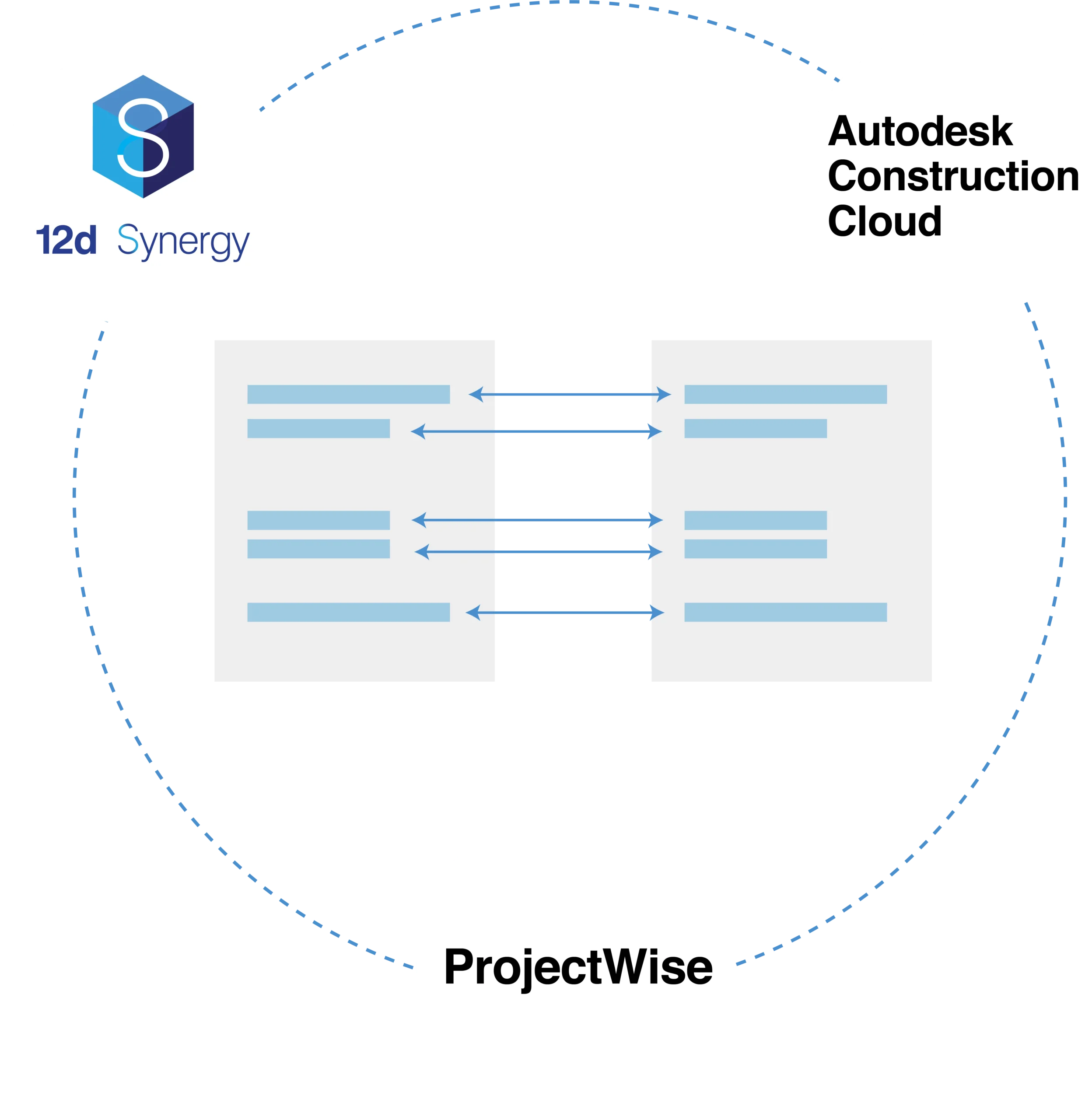
Key Features of Connected Common Data Environments
Connected CDEs introduce advanced functionalities designed to overcome these challenges:
- Interoperability Across Platforms: Open CDEs facilitate seamless integration with various software tools used by different stakeholders, ensuring a unified workflow and reducing data fragmentation.
- Automated Data Synchronisation: Real-time data updates and synchronisation eliminate the need for manual data entry, minimising errors and ensuring all parties have access to the latest information.
- Enhanced ISO 19650 Compliance Across Systems: While single CDEs support ISO 19650 compliance within a single system, Connected CDEs extend this by enabling the exchange of metadata across multiple platforms. This ensures consistent information management and compliance even in distributed, multi-system environments, supporting seamless collaboration across the entire project ecosystem.
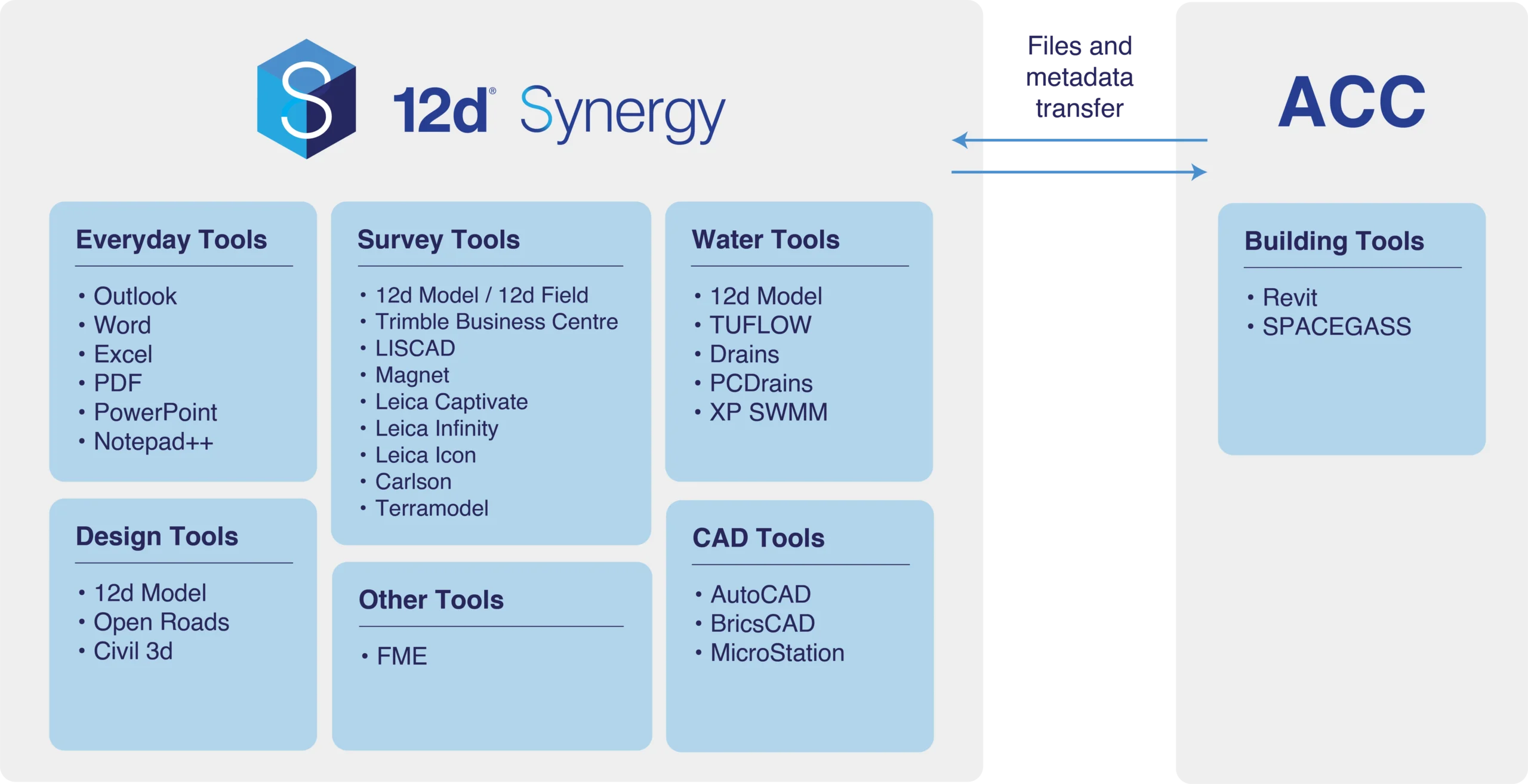
Benefits of Implementing a Connected Common Data Environment
Adopting a Connected CDE yields significant advantages like:
- Enhanced Collaboration: By providing a unified platform, Connected CDEs ensure that all stakeholders can access and share information effortlessly, fostering better teamwork and reducing misunderstandings.
- Increased Efficiency and Cost Savings: Automated processes and real-time data access streamline workflows, reducing delays and lowering the costs associated with errors and rework.
- Reduced Manual Work and Freed-Up Resources: By automating repetitive tasks like data transfers, file naming, and document routing, a Connected CDE removes the burden of mundane admin work from project teams. This allows staff to focus on higher-value, strategic tasks rather than spending hours managing files or manually moving data between systems.
- Improved Decision-Making: Access to consistent and accurate data enables project managers and stakeholders to make informed decisions promptly, enhancing project outcomes.
Connected CDEs address the inherent limitations of traditional CDEs by enhancing interoperability, automating data processes, and ensuring compliance with international standards. These improvements lead to more efficient project execution, cost reductions, and improved collaboration among all parties involved in construction projects.
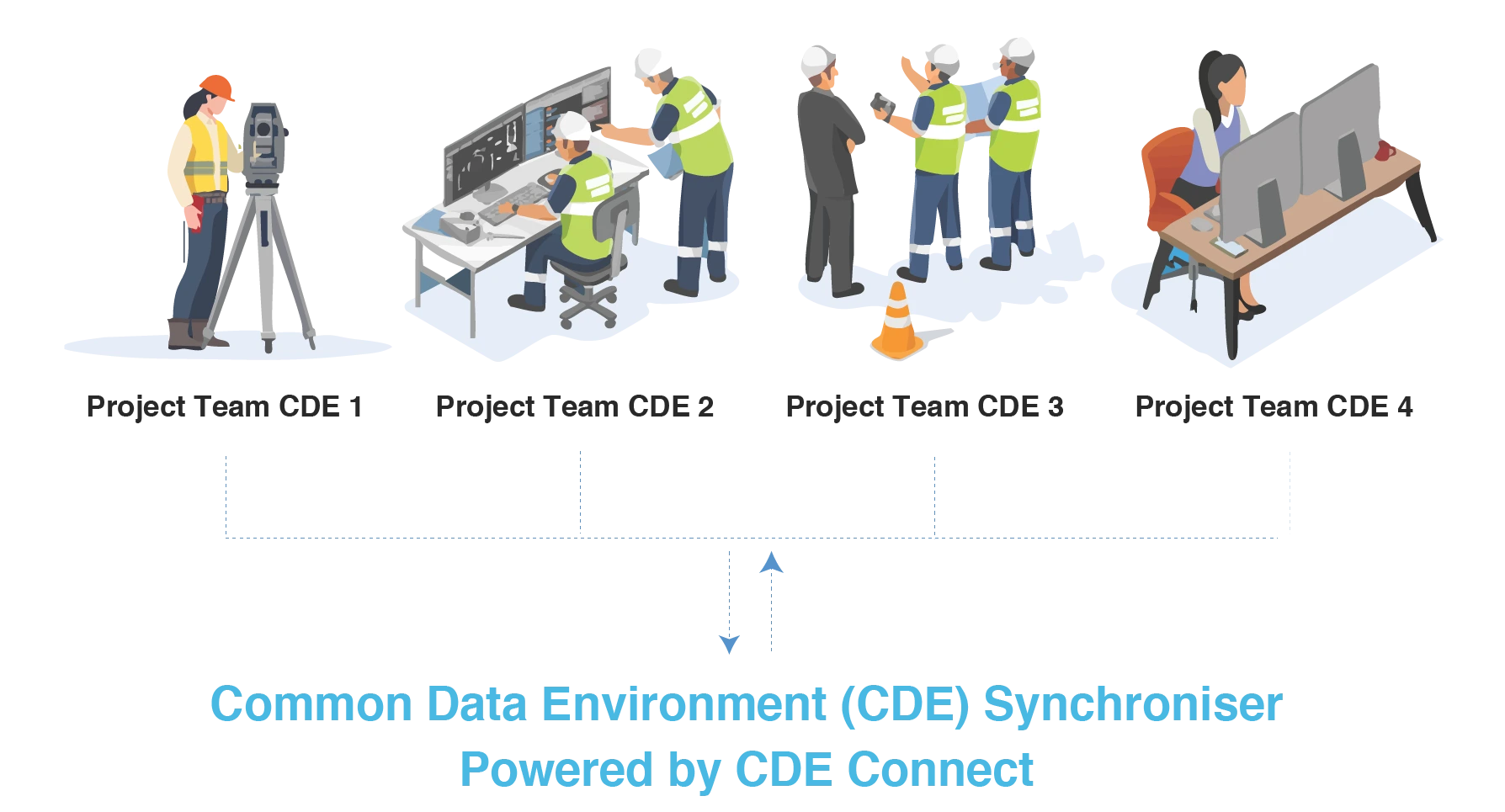
Get the Connected CDEs eBook!
Don’t have time to read the full pillar page right now? Download our free in-depth eBook and share it with your team to explore how Connected CDEs can transform your data workflows—when it suits you.

Chapter 4:
The Role of Connected CDEs Across the Project Lifecycle
Imagine you’re a design manager coordinating multiple consultants, each using different tools. Email threads, network drives, and inconsistent file names make it hard to track the latest version. Or you’re a site engineer trying to access drawings on your phone—only to realise the version uploaded last week is already out of date.
These aren’t edge cases—they’re everyday realities for AEC professionals delivering complex projects with diverse teams, systems, and delivery models.
Connected Common Data Environments (Connected CDEs) don’t replace the systems teams are already using—they connect them. They help ensure accurate information exchange, reduce rework, and support compliance with standards like ISO 19650, across all project stages.
Here’s how Connected CDEs enhance each phase of the project lifecycle through the lens of the people who use them:
1. Concept & Feasibility Stage
For a Development Manager or Urban Planner
You’re tasked with scoping a major infrastructure project. The architect is still finalising concepts, while cost estimators are working off old PDFs. You’re in endless meetings trying to align teams that don’t have access to the same base data.
• Challenge: Disconnected teams struggle to align project goals, leading to misaligned expectations.
• Connected CDEs as Solution: A central repository for early-stage design data, feasibility reports, and initial cost estimates ensures all stakeholders are on the same page.
2. Design Stage
For a BIM Manager or Lead Consultant
You’re coordinating multiple design disciplines, but different tools and email threads mean files are constantly being duplicated, overwritten, or lost. A critical clash wasn’t caught until a week before issue for tender.
- Challenge: Fragmented tools and inconsistent version control cause design conflicts and inefficiencies.
- Connected CDEs as Solution: Enables real-time collaboration, version tracking, and automated clash detection. All team members – architects, engineers, consultants – work from the same coordinated model, dramatically reducing rework.
By connecting systems already in use, a Connected CDE promotes smoother collaboration without changing existing tools.
3. Pre-Construction & Procurement Stage
For a Quantity Surveyor or Commercial Manager
You’re trying to finalise procurement packages, but contracts, tender documents, and design revisions are spread across inboxes and shared drives. You spend more time chasing documents than managing value.
- Challenge: Contract documentation and procurement data are often siloed, leading to delays and duplication.
- Connected CDEs as Solution: Provides a single source of truth for tenders, contracts, and procurement schedules. Integrated workflows with contract management software streamline reviews, approvals, and audit trails.
Connected CDEs ensure that procurement data, including cost estimates and supplier information, is automatically updated and accessible to relevant stakeholders. This real-time data sharing improves decision-making and reduces procurement cycle times.
4. Construction Stage
For a Site Engineer or Construction Manager
You’re onsite, trying to mark out for a foundation pour. You pull up the plan on your tablet only to realise it’s the version from three revisions ago. Nobody told you the wall shifted.
- Challenge: Field teams often lack real-time access to the latest designs, leading to costly mistakes and rework.
- Connected CDEs as Solution: Mobile-enabled access ensures site teams always have the most current drawings, RFIs, and instructions. Automated Data Flows sync site data with office systems in real time, keeping everyone aligned.
Connected CDEs’ real-time data synchronisation ensures that any changes made in the office are immediately available to field teams. This continuous data exchange minimises errors and enhances on-site productivity.
5. Handover & Operations
For a Facility Manager or Asset Information Lead
You’ve inherited a building, but the handover package is incomplete and poorly structured. You spend weeks trying to match assets in the field with outdated spreadsheets and PDFs.
- Challenge: Inconsistent or missing as-built data complicates operations and maintenance.
- Connected CDEs as Solution: Structured asset information and digital twin integration ensure smooth, ISO 19650-3-compliant handovers. Facility managers get clean, accessible data to operate and maintain the asset from day one.
Connected CDEs support the seamless transfer of asset data into facility management systems, ensuring that operational teams have immediate access to accurate and comprehensive information.
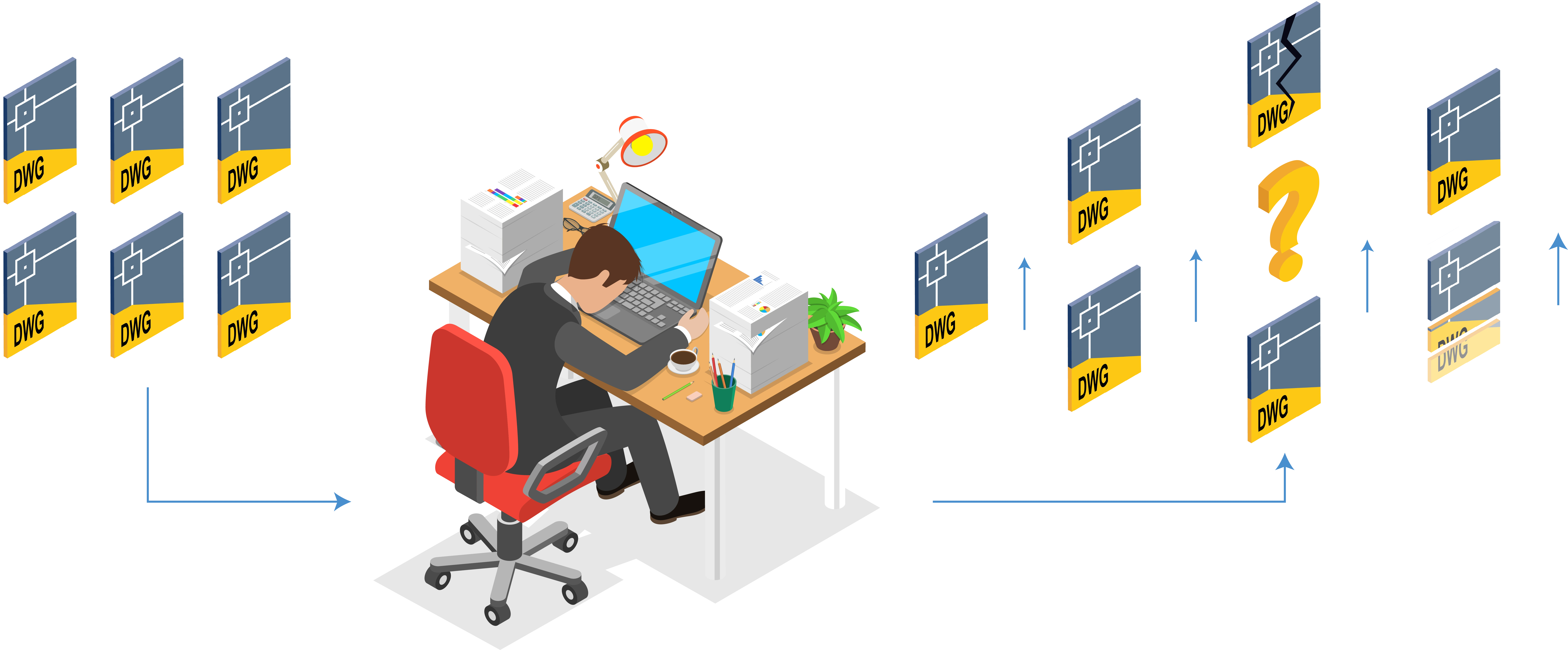
Difference Between Connectors and Connected CDEs
In the AEC industry, integration has often meant setting up point-to-point connectors between tools, for example, linking your BIM platform to your document management system or syncing schedules with an ERP. These integrations solve specific problems, but on their own, they don’t create a connected data environment.
Connected CDEs take this a step further.
At 12d Synergy, our Connected CDE approach is built around two core components: Connectors and Data Flows.
Together, they enable project-wide interoperability and real-time data synchronisation across multiple platforms—ensuring information flows freely, securely, and intelligently from design to handover.
Connected CDEs at 12d Synergy leverage Connectors and Data Flows, two key solutions that eliminate traditional data silos:
Why This Matters
Connectors help remove silos between business-critical systems, but on their own, they don’t create a fully connected data environment. They solve specific integration needs—like syncing project information between 12d Synergy and an ERP system—but don’t address broader interoperability across disciplines, tools, or CDEs.
Data Flows, on the other hand, support structured data exchange across a much wider set of systems and teams. They power the heart of a Connected CDE—ensuring that project data, and the metadata attached to it, is exchanged automatically and accurately throughout the project lifecycle.
This combination allows AEC businesses to:
- Use best-fit tools while maintaining a single source of truth
- Improve compliance, data quality, and team alignment
- Minimise manual effort while maximising collaboration and control
Chapter 5:
Implementing Connected Common Data Environments
Implementing a Connected Common Data Environment can revolutionise data management and collaboration in complex construction projects. However, businesses may encounter several challenges during adoption. This chapter explores these challenges, offers solutions, and outlines steps for successful implementation.
Challenges Businesses May Face When Adopting Connected CDEs
- Resistance to Change: Employees accustomed to traditional workflows may be hesitant to adopt new systems, fearing increased complexity or job security threats.
- Project Complexity and Multiple CDEs: Large projects often involve various stakeholders using different CDEs, leading to issues with data accountability, transparency, and reliability.
- Lack of Early Planning: Not incorporating CDE planning in the project’s initial phases can result in misaligned objectives and integration difficulties later on.
- Interoperability Issues: Ensuring that Connected CDEs integrate all their existing tools and systems seamlessly is crucial but can be challenging.
- Data Security Concerns: Centralising sensitive project data raises concerns about unauthorised access and potential breaches.
Solutions to Overcome These Challenges
- Comprehensive Training Programs: Educate staff on the benefits and functionalities of Connected CDEs to alleviate fears and build confidence.
- Standardisation and Clear Protocols: Establish standardised data management practices and clear protocols for using multiple CDEs to enhance data reliability.
- Early Integration Planning: Incorporate Connected CDE considerations during the project’s planning phase to ensure alignment with project goals and smooth integration.
- Selecting Compatible Solutions: Choose a Connected CDE platform known for its interoperability with existing tools and systems.
- Implementing Robust Security Measures: Adopt stringent access controls, encryption, and regular security audits to protect sensitive data.
Steps to Implement a Connected CDE for Businesses
- Define Clear Objectives: Identify specific goals for adopting a Connected CDE, such as improving collaboration or streamlining data management.
- Engage Stakeholders Early: Involve all relevant parties from the outset to ensure their needs and concerns are addressed.
- Select the Right CDE Platform: Evaluate potential platforms based on scalability, compatibility, and compliance with industry standards.
- Develop a Data Management Strategy: Establish protocols for data structuring, access permissions, and version control.
- Provide Ongoing Training and Support: Offer continuous education and assistance to ensure effective use of the Connected CDE setup.
- Monitor and Evaluate Performance: Regularly assess the system’s effectiveness and make necessary adjustments to optimise performance.
By proactively addressing these challenges and following a structured implementation plan, businesses can successfully integrate a Connected Common Data Environment, leading to enhanced collaboration, efficiency, and project outcomes.
Chapter 6:
Connected Common Data Environments and ISO 19650
Implementing a Connected Common Data Environment in alignment with ISO 19650 standards can significantly enhance information management in construction projects. This chapter explores how Connected CDEs integrate with ISO 19650, its benefits, real-world applications, and addresses common challenges.
How Connected CDEs Work with ISO 19650 Standards
ISO 19650 is an international standard that outlines best practices for managing information over the entire lifecycle of a built asset using Building Information Modeling (BIM). It emphasises the need for a structured approach to information management, promoting collaboration among stakeholders. A Connected CDE serves as the digital platform facilitating this structured approach by:
- Centralising Information: Providing a connected source of truth where all project data is stored, ensuring consistency and accessibility.
- Standardising Workflows: Implementing predefined processes for data creation, sharing, and approval, in line with ISO 19650’s emphasis on standardised information management.
- Enhancing Collaboration: Enabling seamless communication among project participants by offering a unified platform for information exchange.
Benefits of Connected CDEs for ISO 19650 Compliance
Adopting Connected CDEs in line with ISO 19650 offers several strategic and operational advantages for project teams and asset owners:
- Improved Data Integrity: Ensures that all project information is accurate, version-controlled, and always up to date; reducing the risk of errors, rework, and miscommunication.
- Streamlined Processes: Automates key information management tasks such as data validation, approvals, and classification; boosting efficiency and reducing reliance on manual intervention.
- Enhanced Security: Delivers granular access controls, encryption, and audit trails protecting sensitive project and asset data throughout the lifecycle.
- Standardised Information Requirements: Enables asset owners to define and enforce consistent Project Information Requirements (PIRs) and Exchange Information Requirements (EIRs) across multiple projects, platforms, and delivery partners. This creates a scalable and repeatable approach to information delivery, ensuring that all incoming data meets quality standards, regardless of the project’s size, contractor, or technology stack.
- Regulatory Compliance: Facilitates adherence to ISO 19650 and other international frameworks by structuring information in line with standard naming conventions, metadata rules, and approval workflows. This demonstrates a clear commitment to best practice in asset and information management.
Here’s an example of How a Government Transport Authority Scales ISO 19650 Compliance Using a Connected CDE
Imagine a state transport authority overseeing dozens of rail, road, and infrastructure projects, each managed by different contractors, consultants, and technology platforms. Without standardisation, handover documentation varies wildly between projects, requiring costly reformatting, validation, or rework before it can be used in long-term asset management.
With a Connected CDE, the authority can define a consistent set of Project Information Requirements (PIRs) and Exchange Information Requirements (EIRs) that apply to every project, regardless of delivery partner or digital tool. These requirements are embedded into the CDE, automatically validating incoming data, enforcing metadata standards, and ensuring consistency in file naming and classification.
As a result, the transport authority gains:
- Confidence that every asset it receives meets ISO 19650 standards.
- The ability to compare and reuse data across projects and programs.
- Scalable processes that reduce onboarding, training, and validation costs.
This not only future proofs their asset information strategy, but it also simplifies long-term operations, maintenance, and digital twin integration.
Why Standardised Information Delivery Matters for Asset Owners
Connected CDEs allow asset-owning organisations to:
- Define once – apply everywhere: Standardise PIRs and EIRs across all projects and platforms.
- Ensure consistent asset data delivery from every delivery partner.
- Scale up or down with ease without sacrificing data quality.
- Meet ISO 19650 requirements efficiently and repeatably.
- Ideal for authorities managing complex portfolios (e.g. transport, utilities, defence).
Manual Security Measures vs. Connected CDE Automation
Implementing stringent security protocols manually can be labour-intensive and prone to human error, often necessitating dedicated personnel to manage data protection. Connected CDEs address this challenge by automating security measures, including:
- Automated Access Controls: Assigns user permissions based on roles, ensuring that only authorised personnel can access sensitive information.
- Real-Time Monitoring: Continuously tracks data access and modifications, providing audit trails and immediate alerts for suspicious activities.
- Data Encryption: Automatically encrypts data during storage and transmission, protecting it from unauthorised access.
By automating these processes, Connected CDEs reduce the need for manual oversight, minimise the risk of security breaches, and ensure compliance with ISO 19650’s information management requirements.
In summary, integrating Connected CDEs with ISO 19650 standards streamlines information management, enhances collaboration, and automates security protocols, leading to more efficient and secure construction project delivery.
Chapter 7:
Open vs. Closed CDEs
The evolution of Common Data Environments (CDEs) has led to two distinct approaches: Open CDEs and Closed CDEs. Understanding the differences between these models is critical for organisations looking to improve collaboration, data accessibility, and project efficiency. This chapter explores the key differences, benefits, and challenges of each approach and provides guidance on choosing the right CDE for your business.
What Are Open and Closed CDEs?
An Open CDE is like an international airport where various airlines operate freely, while a Closed CDE is like a private airport, accessible only to select flights.
Open CDE: A system that allows interoperability with various software, platforms, and stakeholders, facilitating seamless data exchange across different tools and vendors.
Closed CDE: A proprietary system that restricts access and integrations, often requiring specific software or platforms to operate within a controlled ecosystem.
Key Differences Between Open and Closed CDEs
Pros and Cons of Open and Closed CDEs
Open CDEs
| Pros | Cons |
| Promotes cross-platform collaboration | Requires strict data governance policies |
| Reduces vendor dependency | Potential security risks due to multiple integrations |
| Enhances data sharing and accessibility | More complex to manage and standardise |
| More future-proof and adaptable to new technologies |
Closed CDEs
| Pros | Cons |
| Stronger built-in security controls | Limits collaboration with external stakeholders |
| Easier to manage within a single ecosystem | Increases dependency on a single vendor |
| Vendor support and maintenance provided | Can be more costly in the long run |
Which One is Right for Your Business?
The choice between an Open CDE and a Closed CDE depends on project needs, organisational structure, and long-term data management strategy.
Choose an Open CDE if…
- You work with multiple vendors and stakeholders who use different platforms.
- You need flexibility and long-term scalability.
- You prioritise compliance with open data standards like ISO 19650.
Choose a Closed CDE if…
- You prefer a tightly controlled and secure data environment.
- You are comfortable committing to a single vendor ecosystem.
- You want a simpler implementation with built-in support.
Both Open and Closed CDEs have their advantages and drawbacks. The key is to assess your organisation’s specific needs, collaboration requirements, and security concerns before making a decision. As the industry shifts towards Connected Common Data Environments, open ecosystems are becoming increasingly preferred due to their flexibility, interoperability, and compliance with modern standards.
Chapter 8:
Vision for Connected CDEs – The Future of Data Management
The construction and engineering industries are in the midst of a digital transformation, and Connected CDEs are the foundation for what comes next. As projects become more complex and data-driven, the ability to manage, share, and trust information across the entire project ecosystem is no longer optional. It’s essential.
Connected Common Data Environments represent a shift from siloed, monolithic systems to open, connected environments where data flows freely between platforms, teams, and project phases. It empowers AEC businesses to choose the best tools for the job, regardless of vendor, while knowing those tools will seamlessly integrate and exchange information across the ecosystem.
Imagine a project environment where:
- You’re no longer locked into a single vendor or software suite.
- Every stakeholder, from surveyors to asset owners, can work in their preferred tools while staying connected.
- Data moves automatically and accurately between systems, preserving metadata, reducing duplication, and ensuring version control.
- Project teams can focus on delivering outcomes, not managing files or chasing approvals.
This is the Connected Common Data Environments vision: an open, intelligent, and scalable approach to information management built for the complexity of modern infrastructure, and ready to support the AEC industry’s digital future.
The Future of Data Management
Traditionally, CDEs have been static repositories designed to store documents, not to manage dynamic data ecosystems. Connected CDEs change that. It transforms the Common Data Environment into a living, intelligent platform that connects stakeholders, tools, and systems across the entire asset lifecycle.
Connected CDEs introduce several key advancements:
- Real-time collaboration among owners, designers, contractors, and suppliers on a connected source of truth.
- Automation of repetitive tasks such as approvals, compliance checks, and transmittals, reducing manual overhead and errors.
- Interoperability with multiple platforms and tools, eliminating vendor lock-in and giving project teams the freedom to choose best-in-class solutions.
- Support for open data models and semantic data structures, enabling structured, machine-readable information that can be validated, queried, and reused across systems.
By standardising data from the outset—through metadata, naming conventions, and open schema alignment, Connected Common Data Environments ensure that good data in = good data out. This is crucial not just for delivering better project outcomes, but for creating future-proofed asset models that support AI-powered decision-making, digital twins, and long-term operational excellence.
With clean, structured, interoperable data flowing across a connected ecosystem, asset owners and project teams can:
- Generate insights using AI and analytics tools.
- Enable predictive maintenance and smart operations.
- Integrate with GIS, ERP, and FM systems without data loss or rework.
- Confidently scale across projects, regions, and delivery models.
In short, Connected CDEs aren’t just the future of project data; they’re the foundation for the industry’s digital future.
Key Trends & Innovations in the CDE Ecosystem
1. Artificial Intelligence & Machine Learning
- AI-powered insights can identify project risks early, suggest optimisations, and even automate decision-making processes.
- Machine learning improves data categorisation, making information retrieval more intuitive.
2. Digital Twins & BIM Integration
- Connected CDEs integrate real-time Digital Twin technology, ensuring a live, accurate representation of the built environment.
- Seamless connectivity with BIM platforms ensures that every project participant is working with the latest models.
3. Enhanced Data Interoperability & Open Standards
- The future of CDEs lies in open data ecosystems where different tools communicate seamlessly.
- Standardised APIs and open-source frameworks are removing long-standing vendor lock-ins.
4. Cybersecurity & Automated Compliance
- As data becomes more interconnected, automated security enforcement and compliance checks (aligned with ISO 19650) will become standard.
- End-to-end encryption and blockchain-like audit trails are emerging to enhance trust and data integrity.
5. Cloud-Native & Mobile-First Workflows
- Connected CDEs are built for cloud-native infrastructure, ensuring real-time access from anywhere.
- Mobile-first collaboration tools empower teams to capture and manage data on-site, reducing delays and errors.
Why AEC Businesses Must Adopt Connected Common Data Environments
AEC businesses managing large projects that fail to adopt Connected CDEs risk falling behind in a rapidly evolving industry. The benefits of faster project delivery, reduced costs, and enhanced collaboration far outweigh the challenges of transitioning from legacy systems.
The volume of construction output is projected to grow by 85%, reaching $15.5 trillion worldwide by 2030, underscoring the need for advanced data management solutions like Connected CDEs, according to Intellectsoft. (2)
By embracing Connected CDEs, businesses unlock a connected source of truth across the project lifecycle, greater agility in handling project complexities, a scalable digital foundation for the future of construction, and more.
Want to learn more about it? Reach out to our experts here.
“We needed to keep our live CAD data secure but still give contractors and global partners the information they needed. A connected CDE lets us do both: controlled access for our team, while making the latest data instantly available to partners in Melbourne, Bangkok, or onsite.”
Complete the form below to download our in-depth eBook and share it with your team to explore how Connected CDEs can transform your data workflows—when it suits you.

